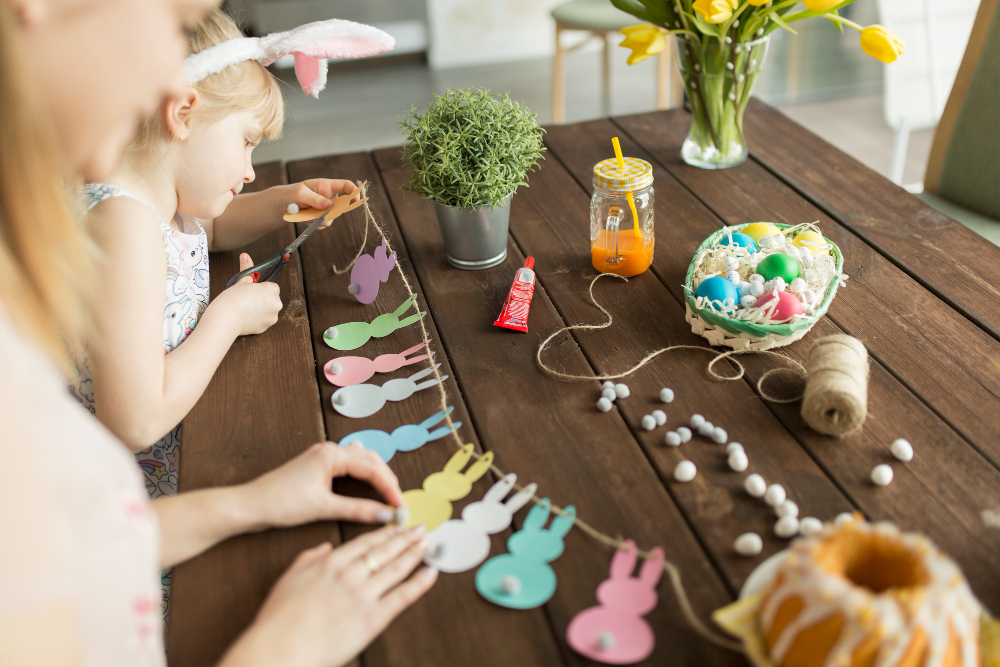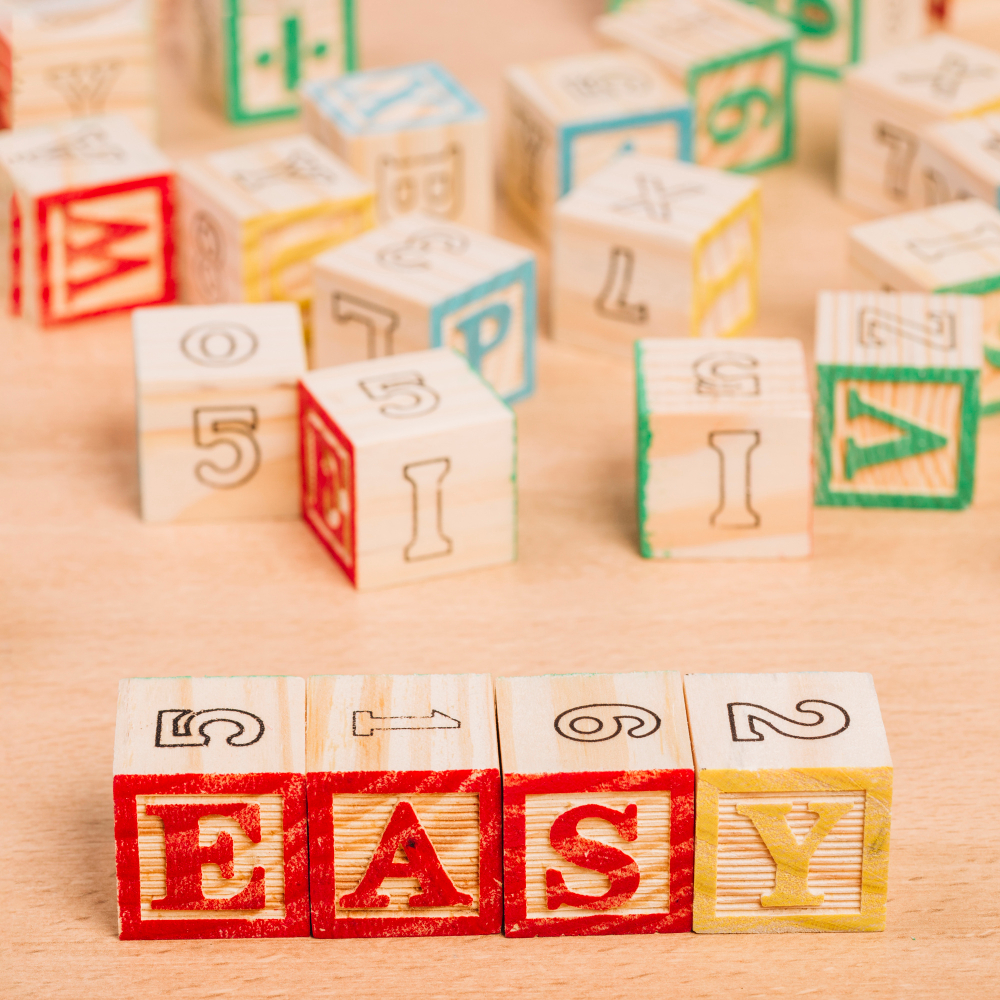
5 Best Ways to Childproof a Bedroom
As parents, one of our foremost preferences is ensuring the safety and well-being of our kids. When it comes to childproofing our homes, the bedroom is a crucial area to concentrate on. Kids spend a considerable amount of time in their bedrooms, and it’s vital to create a safe atmosphere for them to play and nap. In this blog, we’ll explore the five best ways to childproof a bedroom.
Secure Furniture and Electronics
Children are curious explorers, and they often see furniture and electronics as fascinating climbing challenges. To prevent accidents, secure heavy furniture like dressers, bookshelves, and TVs to the wall using safety straps or brackets. One of the best ways to childproof a bedroom is to ensure electrical cords are out of reach and consider using outlet covers to prevent little fingers from poking into sockets.
Choose Child-Safe Bedding
Opt for bedding materials that are free from harmful chemicals and toxins. Look for mattresses and bedding labeled as “hypoallergenic” or “organic.” Ensure that crib mattresses fit snugly in the crib and that there are no gaps that could trap a child. Avoid using pillows, blankets, or stuffed animals in a crib until the child is old enough to sleep with them safely.
Use Safety Gates
When finding ways to childproof a bedroom, safety gates are a parent’s best friend. Placing gates at the bedroom door or the top of stairs can prevent your little one from wandering into potentially dangerous areas. Make sure the gates are sturdy and securely installed to prevent them from being pushed down.
Keep Small Objects Out of Reach
Children love to put things in their mouths, and small objects can be choking hazards. Regularly check the bedroom floor for tiny items like coins, buttons, or small toys when finding ways to childproof a bedroom. Invest in storage solutions like bins, shelves, and toy chests to keep small items out of your child’s reach. This will also help keep the room tidy and organized.
Install Window Safety Measures
Windows can pose a significant safety risk for children. To prevent falls, install window guards or window stops that limit how far the window can be opened. Ensure that blinds or curtains have no accessible cords that a child could become entangled in. Cordless blinds or curtains with a wand control are safer options.
These are the best ways to childproof a bedroom. Childproofing a bedroom is a crucial step in creating a safe and nurturing environment for your little one. By securing furniture, choosing child-safe bedding, using safety gates, keeping small objects out of reach, and installing window safety measures, you can significantly reduce the risk of accidents and provide your child with a safe space to grow and play. Remember, childproofing is an ongoing process, so regularly assess your child’s environment as they grow and develop new skills. Your child’s safety and well-being are worth the effort.

How to Be a Modern Parent: Balancing Tradition and Innovation
In today’s fast-paced world, parenting has evolved to meet the demands of the digital age. Modern parents face unique challenges and opportunities, from navigating screen time to embracing diverse family structures. In this blog, we’ll explore how to be a modern parent by striking a balance between traditional values and innovative approaches.
Communication is Key
One of the fundamental aspects of modern parenting is open and effective communication. In our tech-savvy era, this means not only talking face-to-face but also understanding the digital landscape. Encourage your child to share their thoughts and feelings while being an active listener. By fostering a safe and open environment, you can navigate issues together, from cyberbullying to peer pressure.
Embrace Technology Wisely
Technology is an integral part of our lives, and as a modern parent, we must guide our children’s digital experiences. Set clear rules and boundaries for screen time, but also be open to exploring educational apps and online resources. Teach your kids about online safety, privacy, and responsible internet use.
Flexibility and Adaptability
A modern parent requires flexibility. As our society evolves, so do family dynamics. Whether you’re a single parent, part of a blended family, or in a non-traditional relationship, it’s crucial to adapt and embrace change. Your love and support are what truly matter.
Quality Time Over Quantity
In the hustle and bustle of daily life, finding quality time with your children can be challenging. A modern parent must prioritize quality over quantity. Be present during activities, engage in their interests, and create lasting memories. It’s not about the number of hours spent together but the impact of those moments.
Lead by Example
Modern parenting involves setting a positive example for your children. Whether it’s demonstrating empathy, practicing kindness, or showcasing a strong work ethic, your actions speak louder than words. Children often mimic the behavior they see in their parents, so strive to be the role models they need.
Encourage Independence
While offering guidance is essential, a modern parent also recognizes the importance of fostering independence. Encourage your children to make decisions, solve problems, and learn from their mistakes. This empowers them to become confident and capable individuals.
Nurture a Growth Mindset
In the modern world, adaptability and lifelong learning are invaluable traits. Encourage a growth mindset in your children by praising their efforts rather than just their achievements. Teach them that setbacks are growth opportunities and that failure is a stepping stone to success.
Prioritize Self-Care
A modern parent often juggles numerous responsibilities, from work to household chores. However, don’t forget to prioritize self-care. Taking care of your physical and mental well-being enables you to be the best parent you can be. Make time for hobbies, exercise, and relaxation.
Seek Support and Community
Modern parenting can be isolating, but it doesn’t have to be. Connect with other parents, join parenting groups, and seek support when needed. Sharing experiences and advice can be incredibly reassuring and beneficial.
Unconditional Love
Last but certainly not least, modern parenting is grounded in unconditional love. Regardless of the challenges and changes that come your way, your love for your child remains constant. Let them know that your support and affection are unwavering.
In conclusion, being a modern parent involves a delicate balance between tradition and innovation. By embracing technology wisely, nurturing open communication, and prioritizing quality time and self-care, you can raise confident, resilient, and empathetic children who are well-equipped to thrive in our ever-evolving world. Remember that there’s no one-size-fits-all approach to parenting, and it’s okay to seek help and adapt as needed. Parenthood is an incredible journey, and with love and intention, you can navigate it successfully in the modern era.

10 Red Flags In Teenage Behavior
Navigating the stormy waters of juvenility can be hard for teenagers and their parents. It’s a time of transition, self-discovery, and propelling boundaries. Nevertheless, it’s likewise a time when some teenagers may exhibit concerning behaviors. As a parent, it’s essential to be mindful of these red flags in teenage behavior to furnish vital support and guidance. So here are ten warning signs or red flags in teenage behavior to watch out for:
Impulsive Isolation
If your once-social teenager unexpectedly withdraws from pals and family, spending most of their time isolated in their space, it could be one of the red flags in teenage behavior of emotional distress.
Drastic Mood Swings
While mood swings are expected in teenagers due to hormonal transformations, intense and prolonged changes in mood can display deeper emotional or psychological problems.
Intense Shifts in Academic Performance
An impulsive drop in grades, lack of interest in school, or missing classes can signal educational troubles or underlying issues like stress or depression, which are the red flags in teenage behavior.
Substance Abuse
Experimentation with drugs or liquor is not strange among teenagers, but when it becomes regular and challenging, it’s time for concern and can be deemed as one of the severe red flags in teenage behavior.
Assertive Behavior
Regular outbursts of rage, physical violence, or intense defiance toward authority figures could indicate underlying anger or emotional problems.
Excessive Screen Time
While technology is an essential part of everyday life, extreme screen time, especially late at night, can negatively affect a teen’s mental health and sleep patterns.
Eating Disorders
Severe changes in eating habits, obsession with body image, or substantial weight loss or gain may be signs of an eating disorder like anorexia or bulimia.
Self-harm or Suicidal Thinking
Any symptoms of self-inflicted injuries, like mowing or burning, or expressing thoughts of self-harm or suicide, should be taken very seriously and need prompt proficient help.
Confidential Behavior
While teenagers inherently aim for privacy, outrageous secretiveness, lying, or hiding activities could be signs of inappropriate behavior.
Peer Pressure and Risky Behavior
If your teen caves to peer pressure and engages in scary behaviors like careless driving, substance abuse, or unprotected sex, it’s a sign of vulnerability.
What to Do:
Identifying these red flags in teenage behavior is just the foremost step. Here’s what you can do:
Open-minded Communication: Create a secure space for your teenager to talk openly about their emotions and experiences.
Seek Professional Help: If you witness any symptoms of self-harm, suicidal thoughts, or severe emotional distress, consult a mental health professional immediately.
Set Boundaries: Establish proper rules and boundaries while respecting their growing independence.
Stay Informed: Keep up with their social circles and be mindful of their companions and activities.
Lead by Example: Standard healthy behaviors and coping mechanisms for managing stress and emotions.
Parenting a teenager is not a straightforward task, but being alert about red flags in teenage behavior can help you provide crucial support and direction during this critical stage of their development. Remember that seeking proficient help when needed is a crucial step in ensuring your teenager’s well-being and forthcoming success.

6 Fun and Educational Science Games for Kids
Learning can be an exciting adventure, especially when it comes to science! Are you a parent or a teacher looking for creative ways to engage your kids in scientific concepts? Well, look no further! In this blog, we’ll explore some fantastic and educational science games for kids that make learning a blast. These games are not only entertaining but also educational, helping your little ones grasp scientific concepts with ease.
The Solar System Adventure
Imagine exploring the vastness of space while learning about our solar system. “The Solar System Adventure” is one of the science games for kids that allows kids to journey through the cosmos, visiting planets, moons, and even asteroids. Along the way, they’ll gather interesting facts about each celestial body, all while having fun on their intergalactic journey.
Chemistry Lab Fun
Turn your kitchen into a virtual chemistry lab with one of the most exciting science games for kids! “Chemistry Lab Fun” allows kids to experiment with basic chemical reactions using safe household items. They can create volcanic eruptions with baking soda and vinegar or make colorful slime by mixing different liquids. This hands-on experience introduces them to the world of chemistry enjoyably and educationally.
Dino Discovery
Embark on a prehistoric adventure with “Dino Discovery.” One of these science games for kids allows them to become paleontologists, digging for dinosaur fossils and learning about different species. By uncovering fossils and assembling dinosaur skeletons, they’ll discover fascinating facts about these ancient creatures and the world they lived in.
Weather Wizards
Understanding the weather has never been more fun! “Weather Wizards” teaches kids about meteorology through interactive gameplay. They can create thunderstorms, make rainbows appear, and even control the wind. As they manipulate weather conditions, they’ll gain valuable insights into how our atmosphere works.
Botany Buddies
If your child is curious about plants and gardening, “Botany Buddies” is one of the perfect science games for kids. It lets kids cultivate virtual gardens, plant seeds, and watch them grow into beautiful flowers and plants. Along the way, they’ll discover the essentials of plant biology and learn about the importance of nurturing the environment.
Animal Adventures
“Animal Adventures” is one of the perfect science games for kids that takes them on a global safari to meet different animals in their natural habitats. By observing these creatures in their element, children can learn about animal behavior, ecosystems, and conservation. It’s a wild and educational journey that fosters a love for wildlife.
These educational science games for kids are not only entertaining but also valuable tools for learning. They allow children to explore scientific concepts in a fun and interactive way, fostering a love for science from an early age. So, whether your child is interested in astronomy, chemistry, paleontology, meteorology, botany, or zoology, there’s a game that can spark their curiosity and make science an adventure they’ll cherish forever. Give these games a try, and watch your child’s interest in science soar to new heights!

A Parent’s Guide to Making Money on Instagram
Hey there, parents! Are you a fan of Instagram? Do you enjoy sharing your family’s adventures, parenting tips, and everyday moments with your followers? Well, did you know that it is easy making money on Instagram? That’s right! In this blog, we’ll walk you through some simple ways to turn your love for Instagram into a source of income.
Find Your Niche for Making Money on Instagram
The first step in making money on Instagram is to find your niche. What’s a niche, you ask? It’s like your special area of interest. It could be anything from parenting, cooking, fitness, or even DIY crafts. When you focus on a specific topic, it’s easier to connect with like-minded people and build a loyal following.
Create High-Quality Content
Now that you have your niche, it’s time to start posting content. But remember, quality is key! Take clear, well-lit photos and write engaging captions. Share your personal stories and experiences related to your niche. People love authentic content, so be yourself!
Grow Your Followers
For making money on Instagram, you’ll need followers. Start by following accounts in your niche, engaging with their content, and using relevant hashtags. Don’t forget to interact with your own followers too! Respond to comments and messages to build a strong and engaged community.
Collaborate with Brands for Making Money on Instagram
Once you have a decent following, brands may start noticing you. They might offer you collaborations to promote their products or services. Make sure the products align with your niche and that you genuinely like them. Your authenticity will shine through in your posts, which is what brands are looking for.
Affiliate Marketing
Affiliate marketing is another way to make money on Instagram. You can promote products you love and earn a commission for every sale made through your unique affiliate link. Just be transparent with your followers and let them know when you’re using affiliate links.
Sponsored Posts
As your Instagram following grows, you can approach brands for sponsored posts. This means they’ll pay you to create content featuring their products or services. Make sure the brand fits your niche and that you disclose when a post is sponsored.
Sell Your Own Products
If you have a talent for creating products or services related to your niche, why not sell them on Instagram? You can set up a shop and promote your items to your followers. It’s a great way to turn your passion into profit.
Stay Consistent For Making Money on Instagram
Consistency is key on Instagram. Try to post regularly and engage with your audience consistently. This will help you maintain and grow your following over time.
Be Patient
Making money on Instagram takes time, so don’t get discouraged if things don’t happen overnight. Keep working on your content, engaging with your followers, and exploring new opportunities.
Stay Safe
Lastly, remember to stay safe on Instagram. Protect your personal information and be cautious when sharing details about your family. Unfortunately, not everyone on the internet has good intentions.
In conclusion, making money on Instagram can be a fun and rewarding endeavor for parents. Find your niche, create quality content, grow your following, and explore various monetization options. With time and dedication, you can turn your Instagram hobby into a source of income while sharing your parenting journey with the world.

Is it Possible To Prevent Morning Sickness During Pregnancy?
Nausea, vomiting, or morning sickness during pregnancy is a frequent and often unpleasant symptom that many expectant mothers encounter in the early stages. Morning sickness can be particularly intense in pregnancies with multiples, such as twins or triplets, because of elevated hormone levels. Numerous factors, including hormones and sensitivity, are believed to contribute to the occurrence of morning sickness during pregnancy.
Raised levels of human chorionic gonadotrophin
Fluctuations in hormones, particularly the heightened levels of human chorionic gonadotropin (hCG) and estrogen have a substantial impact on the onset of morning sickness. These hormonal shifts are most prominent during the initial trimester of pregnancy, coinciding with the period when morning sickness is most prevalent.
Elevated sensitivity to odors
Pregnancy can increase an individual’s sensitivity to smells, causing certain odors that were once bearable or even enjoyable to become nauseating. This heightened sensitivity can be a contributing factor to the experience of nausea and vomiting during pregnancy.
Gastrointestinal changes
During pregnancy, alterations in the gastrointestinal tract can occur, such as delayed gastric emptying and relaxation of the lower esophageal sphincter. These changes may lead to acid reflux and the regurgitation of stomach contents, which can be factors contributing to the sensation of nausea or morning sickness during pregnancy and episodes of vomiting.
Hyperemesis gravidarum
Although morning sickness during pregnancy is typically considered a common aspect, there are instances of severe and persistent nausea and vomiting, a condition known as hyperemesis gravidarum. This condition is more severe and can result in dehydration, electrolyte imbalances, and weight loss. If a pregnant individual is experiencing excessive vomiting throughout the day, has difficulty tolerating any food or liquids, exhibits insufficient urine output or discolored urine, feels severely weak, experiences dizziness, or vomits blood, it is indicative of hyperemesis gravidarum. In such cases, pregnant individuals must seek medical attention for appropriate management and treatment.
Here are a few remedies that can alleviate morning sickness condition:
Nausea or morning sickness during pregnancy is a widespread occurrence, affecting the majority of expectant mothers. While it’s commonly referred to as “morning sickness,” it can actually strike at any time of day. Typically, it sets in around the 12-14 week mark of pregnancy, but for certain individuals, it may persist for several more weeks or even throughout the entire pregnancy. To alleviate these symptoms, here are some recommended remedies that involve adjustments to your diet and lifestyle:
- Ensure you get ample rest because fatigue and tiredness can exacerbate nausea and vomiting.
- Steer clear of spicy, greasy, and overly sweet foods.
- Opt for frequent, small meals that are carbohydrate-rich, such as rice, toast, crackers, potatoes, and bananas.
- Stay well-hydrated, but take sips of fluids rather than consuming large quantities, especially during meals.
- Identify and avoid any scents or sounds that trigger your nausea.
- Consider using ginger, which is known for its beneficial effects, particularly when consumed with food or in the form of ginger candies.
- Opt for comfortable clothing and maintain well-ventilated rooms to enhance your comfort.
- Engage in activities to distract yourself and seek support from your family when needed.
In conclusion, while it may not always be feasible to fully prevent nausea and morning sickness during pregnancy, there are undoubtedly measures expectant mothers can take to alleviate the symptoms and make this period more comfortable. Simple transformations in diet and lifestyle, such as consuming smaller, more frequent meals, avoiding trigger foods, and staying well-hydrated, can go a long way in managing these symptoms.

A Guide to Teaching Black Kids About Racism
Racism is an extremely rooted subject in our community, and we must address it sincerely and frankly with our kids. For Black parents, teaching their children about racism is not just a preference but a need. The talks around racism can be challenging, but they are necessary for providing youthful minds with the ability and strength required to guide a world that is frequently unjust. In this blog post, we will explore effective ways of teaching black kids about racism.
Start Early
The foremost phase of teaching Black kids about racism is to begin early. Kids begin to witness differences in skin color at a very young age, and it’s crucial to provide them with context and knowledge from the beginning. Use age-appropriate books, toys, and media to introduce diversity and multiculturalism into their lives. Honor differences and teach them that everyone deserves respect and kindness, regardless of their skin color.
Use Relatable Examples
When discussing racism with your child, use relatable examples that they can understand. For example, you can use day-to-day situations like sharing toys to explain the concept of fairness and equality. Ask them how they would feel if somebody treated them unfairly because of their skin color, and foster empathy and understanding.
Emphasize Strength and Resilience
When teaching black kids about racism, share some examples of the strength and resilience of Black individuals and communities throughout history. Share stories of Black leaders, activists, and artists who have made significant contributions to society. Emphasize that even in the face of adversity, Black people have achieved remarkable things, and your child can too.
Encourage Questions
Encourage your child to ask questions about racism and be prepared to answer them honestly. It’s essential to create a safe space where your child feels comfortable discussing their thoughts and feelings about racial issues. Be patient and provide age-appropriate explanations, ensuring that your child understands that racism is about discrimination and prejudice, not innate characteristics.
Address Stereotypes
Discuss racial stereotypes and how harmful they can be. When teaching black kids about racism, allow them to recognize and challenge stereotypes when they encounter them. Help them understand that stereotypes are unfair generalizations that do not represent the diversity and complexity of individuals from any racial or ethnic group.
Explore Cultural Heritage
Praise your child’s cultural heritage and help them embrace their identity. Teach them about their family’s history, traditions, and customs. Understanding their cultural background can empower your child and help them develop a strong sense of self.4
Promote Inclusivity
Encourage your child to be inclusive and to stand up against racism when they witness it. When teaching black kids about racism also tells them the importance of being allies to others who face discrimination. Emphasize that making the world a more just and equitable place is a collective effort.
Model Anti-Racist Behavior
Children learn by example, so it’s crucial to model anti-racist behavior in your own life. Show your child that you are committed to fighting racism through your actions, words, and choices. This consistency will reinforce the values you are instilling in them.
Teaching Black children about racism is an ongoing process that requires patience, empathy, and open communication. By beginning early, providing relatable examples, and fostering a sense of cultural pride, you can equip your child with the knowledge and resilience required to confront racism and discrimination in the world. Remember that you are not alone in this journey, and there are resources and communities available to support you and your child along the way. Together, we can work towards a more inclusive and equitable society for all.

Easy & Simple Yes Or No Questions To Ask Your Kids
Having meaningful conversations with your children is a fantastic method to strengthen your connection and gain deeper insight into their thoughts and passions. An excellent approach to initiating these conversations is by posing uncomplicated yes-or-no inquiries. Such questions are straightforward for kids to respond to and can pave the way for more profound conversations. In this piece, we’ll furnish you with an extensive collection of simple yes or no questions to ask your kids. Whether you’re in search of amusing questions, questions regarding the natural world, or questions tied to their beloved pastimes, we’ve got you completely covered.
Here are simple yes or no questions to ask your kids:
- Have you ever dreamed of going on a magical adventure?
- Would you like to learn how to cook your favorite meal?
- Can you imagine what it’s like to be a superhero for a day?
- Is watching a beautiful sunset your favorite way to end the day?
- Do you enjoy getting lost in the pages of a good book?
- Can you create a masterpiece with your crayons and paper?
- Would you like to explore the mysteries of outer space?
- Do you think animals can understand our feelings?
- Have you ever wished you could have a pet dragon?
- Is scoring a winning goal the best feeling in the world?
- Do you believe you can be anything you want when you grow up?
- Would you like to know how the universe works?
- Have you ever wondered what it’s like to explore the depths of the ocean?
- Can music make you feel different emotions?
- Would you go on a quest to find hidden treasure if you could?
Encouraging conversation with your children through these simple yes or no questions to ask your kids can offer a window into their likes, passions, and viewpoints. Be sure to actively listen and prompt them to expand on their responses. Relish these conversations as chances to forge a stronger bond with your kids, all while having an enjoyable time together.

These 20 Smartest Animals In The World Will Blow Your Mind
The animal kingdom is a treasure trove of fascinating creatures, each with its unique set of abilities and intelligence. While we often associate intelligence with humans, many animals exhibit remarkable cognitive skills that can leave us in awe. In this blog, we’ll embark on a journey to discover the 20 smartest animals in the world. From problem-solving parrots to tool-using octopuses, the animal kingdom is full of surprises that will truly blow your mind!
Dolphins

Dolphins come number one on the list of smartest animals in the world. Dolphins are known for their sophisticated communication skills, using a complex system of clicks and whistles to convey messages and even names among themselves.
Chimpanzees

Chimpanzees share 98% of their DNA with humans, making them our closest relatives in the animal kingdom. They exhibit remarkable problem-solving abilities and use tools to obtain food.
Elephants

Elephants possess an impressive memory and can remember the locations of water holes and complex social structures within their herds, thus making them one of the smartest animals in the world.
Border Collies – The Genius Dogs

Border Collies are often considered the smartest dog breed and one of the smartest animals in the world. They excel in agility, obedience, and problem-solving tasks, making them outstanding working dogs.
Ravens

Ravens are renowned for their problem-solving skills and have been observed using tools and even cooperating with other ravens to achieve their goals.
Octopuses

Octopuses are not only masters of camouflage but also excel at opening jars, solving mazes, and escaping from enclosures, showcasing their exceptional problem-solving abilities.
African Grey Parrots

African Grey Parrots are famous for their ability to mimic human speech, but they also possess advanced problem-solving skills and a keen sense of observation.
Pigs

Pigs are highly intelligent animals that can learn tricks, solve puzzles, and even play video games. They have excellent memories and can adapt to new environments, that’s the reason they are on the list of smartest animals in the world.
Rats

The Tiny Problem Solvers Rats have demonstrated impressive problem-solving abilities in lab experiments, which have helped us better understand their cognitive capabilities.Cephalopods

Cephalopods, including cuttlefish and squids, are renowned for their ability to adapt rapidly to changing environments and are skilled hunters that’s the reason why they are on the list of smartest animals in the world.
New Caledonian Crows

New Caledonian crows are exceptional tool users, creating intricate tools to obtain food, such as using sticks to extract insects from tree bark.
Bonobos

Bonobos are highly intelligent and share many cognitive abilities with chimpanzees. They are known for their peaceful and cooperative social behaviors.
Bees

Honeybees exhibit complex navigation skills and excellent memory, allowing them to locate food sources and communicate with their fellow hive members through intricate dances.
Squirrels

Squirrels are expert problem solvers, using their memory and problem-solving abilities to hide and retrieve their food caches that’s the reason they are on the list of smartest animals in the world.
Orcas

Orcas, also known as killer whales, are highly intelligent marine mammals that hunt in coordinated packs, using complex communication and problem-solving strategies.
Ants

Ants may be tiny individually, but collectively, they form highly organized colonies that demonstrate impressive problem-solving abilities.
Raccoons

Raccoons have adapted to urban environments, showcasing their problem-solving skills as they navigate complex human-made obstacles to find food that’s the reason they are on the list of smartest animals in the world.
Hyenas

Hyenas are skilled hunters with complex social structures and cooperative hunting tactics, demonstrating their intelligence and adaptability.
Eleonora’s Falcons

Eleonora’s falcons are migratory birds that exhibit impressive navigation skills during their long journeys across continents.
Manta Rays

Manta rays have demonstrated remarkable learning abilities, remembering individual divers and even seeking their assistance when in need.
The world is teeming with intelligent and awe-inspiring animals, each with its unique talents and cognitive abilities. From the problem-solving prowess of dolphins and chimpanzees to the tool-using skills of crows and octopuses, these 20 smartest animals in the world remind us of the incredible diversity and complexity of life on Earth. As we continue to explore and understand the animal kingdom, we uncover even more evidence that intelligence is not limited to humans and that the natural world is full of extraordinary minds waiting to be discovered.

What You Need To Know About RSV Symptoms in Kids
As a parent or guardian, it’s imperative to be well-informed about standard childhood illnesses and their symptoms. Respiratory Syncytial Virus (RSV) is one such infection that can affect children, particularly infants and toddlers. Understanding RSV symptoms in kids is essential for convenient diagnosis and cure. Throughout this blog, we will discuss what RSV is, its symptoms in children, and prevention measures.
What is RSV?
RSV – Respiratory Syncytial Virus is a common respiratory virus that can impact people of all ages, but it’s most concerning for infants and young children. RSV is highly infectious and usually spreads through respiratory droplets when an infected person coughs or sneezes. It typically circulates during the fall and winter months, making it a prevalent concern for parents during these seasons.
Common RSV Symptoms in Kids
RSV can emulate the signs of the common cold or flu in older children and adults. Nonetheless, in infants and young children, RSV can lead to more severe respiratory symptoms. Here are the specific RSV symptoms in kids:
Coughing and Sneezing: Children with RSV usually have a persistent cough and may sneeze frequently.
Runny or Stuffy Nose: RSV can cause nasal congestion, leading to a runny or stuffy nose.
Fever: A low-grade fever is expected in RSV-infected children, but some may have higher fevers.
Wheezing: Wheezing, a high-pitched whistling sound when breathing, RSV symptoms in kids cases. It can be a sign of lower respiratory tract involvement.
Rapid Breathing: Infants with RSV may breathe more rapidly than usual, and their nostrils may flare with each breath.
Difficulty Breathing: In severe cases, RSV can cause significant breathing difficulties, including retractions (sucking in the chest muscles), which require immediate medical attention.
Irritability and Reduced Activity: Infants and young children with RSV may become fussier than usual and have decreased activity levels.
Loss of Appetite: RSV can lead to a reduced appetite in children, which can result in dehydration if not managed properly.
Blue Lips or Nails: This is a rare but serious symptom of severe RSV infection and requires immediate medical attention.
Preventing RSV Infections
Preventing RSV infections is vital, especially for high-risk children. Here are some preventive measures you can take:
Handwashing: Frequent handwashing is the first line of defense against RSV or RSV symptoms in kids and other contagious illnesses.
Avoiding Close Contact: Keep sick individuals away from babies, and limit close contact with anyone showing symptoms.
Cough and Sneezing Etiquette: Teach children to cover their mouths and noses when coughing or sneezing.
Vaccination: While there is no RSV vaccine, pregnant women can receive a vaccine called Synagis, which can reduce the severity of RSV in newborns.
Good Hygiene Practices: Disinfect frequently touched surfaces, and avoid sharing items like cups and utensils.
Respiratory Syncytial Virus can cause mild to severe symptoms in children, particularly in infants and those with underlying health conditions. Being aware of RSV symptoms in kids, its risk factors, and prevention strategies is essential for protecting your child’s health. If your child exhibits severe symptoms or has risk factors for severe RSV, consult a healthcare professional promptly. With the right knowledge and precautions, you can help keep your child healthy and safe from RSV and other contagious illnesses.

5 Sleeping Tips for Teething Babies
As a new mom, you’re likely to encounter a flood of parenting advice that can be overwhelming. Your little one might experience considerable discomfort during teething, leading to disruptions in their sleep patterns. Consequently, we would like to share some valuable tips to help teething babies get a good night’s sleep.
Make Sure The Baby Has Something Cold To Chew On
Cold has the ability to desensitize nerves, thereby diminishing pain sensation. This is why in recent times, many toy manufacturers have begun producing teethers with rubber or gel-core components that can be placed in the refrigerator. These teethers are specially designed for teething babies and are intended to be gnawed upon. The act of a baby chewing on these teethers exerts gentle pressure on their emerging teeth, offering them relief from the discomfort associated with teething. The inclination to chew as a means of alleviating teething pain is an instinct shared by both humans and animals.
Massage The Gums
When your baby begins teething, they may resist sleeping alone. When you place your baby in their crib, try gently massaging their gums with your finger. This soothing touch can alleviate discomfort and assist in getting your baby to sleep. If your baby wakes up during the night, you can repeat the gum massage. As you massage your baby’s gums, you’ll be able to sense where their new teeth are emerging. Concentrate on massaging these specific areas. It’s essential to ensure that your fingers are clean before massaging your baby’s gums for hygiene and comfort.
Create A Peaceful Atmosphere
Establishing a consistent sleeping schedule is crucial for helping your baby get a good night’s sleep. When babies have a regular sleep routine, their bodies adapt accordingly. A bedtime ritual can naturally induce drowsiness as bedtime approaches. It subliminally communicates that it’s time to sleep when specific activities are carried out in a predictable sequence, much like the way habits are formed. This routine might encompass elements such as giving your baby a warm bath, changing into pajamas, reading a brief story, singing to your baby, or gently rocking them in your arms until they drift off to sleep.
Breastfeed Is A Great Option For Teething Babies
Breastfeeding has a calming effect on your baby. However, as teething babies, they may sometimes nibble on your nipples, which can be uncomfortable or painful for you. To avoid this, consider massaging your baby’s gums before each feeding session. Breastfeeding remains an effective method for soothing your baby and helping them drift off to sleep peacefully.
Use Pain-killing Prescription
Only consider this option as a last resort if you’ve exhausted all other methods without achieving any improvement. Pain relievers can be effective in easing your baby’s discomfort and helping them sleep. However, it’s imperative to consult with your doctor before considering medication. Avoid purchasing over-the-counter pharmaceutical products for this purpose. Pain relievers like Ibuprofen are available in specially formulated, diluted versions designed specifically for children and infants. Never administer adult pain relievers to your baby. Always seek guidance from your pediatrician before giving any medication to your little one.
In conclusion, navigating the challenging waters of teething with a baby requires patience, understanding, and a few clever tricks up your sleeve. The five sleeping tips for teething babies outlined in this blog post offer a lifeline for exhausted parents, helping both little ones and caregivers get the rest they need during this trying time.

How to Stop Leaky Breasts
Life is a ravishing journey filled with many incredible milestones, and one of the most magical experiences is becoming a mother. However, this journey can also bring unexpected challenges, and one of them is dealing with leaky breasts. While it may not be a topic commonly discussed in everyday conversation, it’s a very real and common occurrence for many new moms. In this blog, we’ll delve into what causes leaky breasts and provide practical tips on how to manage and cope with this natural phenomenon.
Understanding the Why
Before we jump into solutions, let’s explore why leaky breasts happen in the first place. Leaky breasts are a natural part of the postpartum journey, primarily due to hormonal fluctuations. When you’re pregnant, your body starts preparing for breastfeeding by increasing the production of prolactin, the hormone responsible for milk production. However, it’s not until after childbirth that milk production fully kicks in, and that’s when leaky breasts often make their debut.
Invest in Nursing Pads
One of the first things you’ll want to do to manage leaky boobs is to invest in nursing pads. These handy little pads are designed to fit inside your bra and absorb any leaked breast milk, keeping your clothing dry and comfortable. They come in disposable and reusable options, allowing you to choose what works best for you and the environment.
Wear a Supportive Bra
Wearing a comfortable and supportive bra is crucial for managing leaky breasts. Look for bras designed specifically for nursing mothers. They often have convenient features like easy-to-open clasps for breastfeeding and extra padding to help conceal any leakage. A well-fitting bra can also help alleviate some of the discomfort that can come with engorged breasts.
Practice Good Breast Hygiene
Maintaining good breast hygiene is essential when dealing with leaky breasts. Ensure that you clean your breasts daily with warm water and mild soap, and gently pat them dry. Avoid using harsh chemicals or fragrances near your breasts, as these can irritate your skin.
Nursing on Demand
Frequent breastfeeding or pumping can help alleviate breast fullness and reduce leakage. Nursing your baby on demand helps regulate your milk supply and can be a natural way to reduce the chances of leakage.
Engage in Breastfeeding Techniques
Learning proper breastfeeding techniques can also help you manage leaky breasts. Consider reaching out to a lactation consultant for guidance on ensuring a proper latch, which can reduce the chances of milk leakage during feeds.
Stay Hydrated and Maintain a Healthy Diet
Your body requires extra hydration and nutrients while breastfeeding, so it’s essential to stay well-hydrated and maintain a balanced diet. A well-nourished body is better equipped to handle the demands of milk production.
Express Excess Milk
If you find that you have an oversupply of milk and are experiencing significant leakage, consider expressing excess milk between feedings using a breast pump. This not only helps manage the issue but also allows you to build a milk stash for later use.
Leaky breasts are a natural and temporary part of the breastfeeding journey for many new moms. While they can be surprising and even a bit inconvenient at times, there are practical steps you can take to manage and cope with them. Remember that this phase will pass as your body adjusts to the demands of breastfeeding, and in the meantime, take comfort in the beautiful bond you’re creating with your little one through this incredible journey of motherhood.

How to Fight Pregnancy Fatigue Naturally
As you go through pregnancy, it becomes more important to learn how to fight pregnancy fatigue naturally. As your body undergoes incredible changes to nurture and grow your baby, it’s natural to feel tired at times. However, there are plenty of natural ways to fight pregnancy fatigue and boost your energy levels. In this blog, we’ll explore some effective tips to help expecting moms feel more refreshed and energized during this exciting time in their lives.
Prioritize Sleep
Getting enough rest is crucial during pregnancy. Hormonal changes, discomfort, and the need for more frequent trips to the bathroom can disrupt your sleep. To combat this, create a soothing bedtime routine. Try using pillows for support, sleep on your left side to improve blood flow to your baby, and keep your room dark and quiet.
Stay Hydrated
Dehydration can contribute to fatigue, so make sure you’re drinking enough water when trying to fight pregnancy fatigue naturally. Carry a reusable water bottle with you throughout the day, and consider infusing your water with slices of lemon or cucumber for a refreshing twist.
Balanced Nutrition
Eating a well-balanced diet can go a long way in combating pregnancy fatigue. Focus on whole foods, lean proteins, fruits, vegetables, and whole grains. These foods provide essential nutrients and steady energy throughout the day. Avoid sugary snacks, which can lead to energy crashes.
Frequent, Small Meals
Instead of three large meals, opt for smaller, more frequent meals and snacks when trying to fight pregnancy fatigue naturally. This can help stabilize your blood sugar levels and keep your energy levels consistent. Include healthy snacks like nuts, yogurt, or fruit to curb hunger and maintain energy.
Exercise Regularly
While it may seem counterintuitive, light to moderate exercise can actually boost your energy levels during pregnancy. Activities like prenatal yoga, swimming, or walking can improve circulation and help you feel more invigorated. Always consult with your healthcare provider before starting a new exercise routine.
Listen to Your Body
Pregnancy is not the time to push yourself to the limit when trying to fight pregnancy fatigue naturally. If you’re feeling exceptionally tired, allow yourself to rest. Even a short nap or a few moments of relaxation can recharge your batteries.
Stress Reduction Techniques
Stress can exacerbate fatigue, so it’s important to find ways to manage it. Meditation, deep breathing exercises, and prenatal massage can help alleviate stress and promote relaxation.
Iron-Rich Foods
Iron deficiency can contribute to pregnancy fatigue, so include iron-rich foods in your diet when trying to fight pregnancy fatigue naturally. Leafy greens, lean meats, and fortified cereals can help boost your iron levels.
Stay Connected
Share your feelings and experiences with your partner, friends, and family. Emotional support can be a powerful energy booster during pregnancy.
Prenatal Vitamins
Consult with your healthcare provider to ensure you’re taking the appropriate prenatal vitamins. These supplements can fill in nutritional gaps and help combat fatigue.
Pregnancy fatigue is a common and expected part of the journey, but it doesn’t have to dominate your experience. By prioritizing rest, nourishing your body with the right foods, staying active, and managing stress, you can fight pregnancy fatigue naturally and enjoy this remarkable time in your life to the fullest. Remember, every pregnancy is unique, so it’s essential to listen to your body and seek guidance from your healthcare provider when needed. Embrace this beautiful journey, and take care of yourself along the way.

The RIE Parenting Method: What Is It?
Parenthood is a journey filled with joy, challenges, and countless decisions. One of the most crucial choices parents face is how to raise their children. In recent years, there has been a growing interest in alternative parenting approaches that focus on fostering independence, respect, and emotional well-being in children. One such approach is the RIE (Resources for Infant Educarers) parenting method. In this blog post, we’ll delve into what RIE parenting is all about and explore its key principles.
Understanding RIE Parenting
This sort of parenting, founded by the late Magda Gerber and pediatric neurologist Emmi Pikler, is an approach that emphasizes treating infants and young children with respect and trust while promoting their natural development. RIE parenting is not just a set of rules but rather a philosophy that can be applied from infancy through early childhood.
Key Principles
Respect for the Child’s Individuality
Central to RIE parenting is the belief that each child is a unique individual with their own needs, preferences, and pace of development. Parents practicing RIE strive to understand and acknowledge their child’s individuality, even from a very young age.
Observation
RIE parenting encourages parents to become keen observers of their child’s behavior, needs, and cues. By closely watching their child, parents can better understand what their child is communicating and respond appropriately.
Uninterrupted Play
RIE advocates for providing children with uninterrupted, child-directed playtime. This means allowing children the freedom to explore and discover the world at their own pace, without constantly intervening or offering distractions.
Setting Boundaries and Limits
While RIE parenting promotes independence, it also recognizes the importance of setting clear and consistent boundaries. Children thrive when they know what is expected of them, and RIE parents aim to communicate these expectations respectfully.
Responsive Caregiving
RIE parenting emphasizes prompt and thoughtful responses to a child’s needs. This approach builds trust and helps children feel secure, knowing that their needs will be met.
No Baby “Training” Tools
RIE discourages the use of various baby “training” devices, such as walkers or bouncers, which can interfere with a child’s natural development and mobility.
Avoiding Praise and Criticism
RIE suggests avoiding excessive praise or criticism and instead opting for honest and specific feedback. This helps children develop a realistic self-concept and a sense of intrinsic motivation.
Benefits of RIE Parenting
Emotional Well-being: RIE parenting encourages emotional intelligence by allowing children to express their feelings and learn how to manage them in a supportive environment.
Independence and Confidence: By fostering independence and autonomy from a young age, RIE children often develop a strong sense of self and confidence in their abilities.
Strong Parent-Child Bond: This parenting emphasizes the importance of a trusting and respectful relationship between parents and children, strengthening the parent-child bond.
Respectful Communication: RIE techniques promote open and respectful communication between parents and children, setting the stage for healthy relationships later in life.
Is RIE Parenting for Everyone?
While the parenting method has gained a following among many parents who appreciate its focus on respect and independence, it’s essential to remember that no single parenting approach is a one-size-fits-all solution. Every family is unique, and what works for one may not work for another. RIE parenting may resonate with some parents but not with others, and that’s perfectly okay.
RIE parenting is a philosophy that values respect, observation, and trust in nurturing children’s growth and development. By emphasizing individuality, independence, and responsive caregiving, this sort of parenting offers an alternative approach for parents who seek to raise emotionally intelligent, confident, and respectful children. Ultimately, the key to successful parenting lies in finding a balance that aligns with your family’s values and the unique needs of your child.

The Best Way To Teach Your Child About The Holocaust
Teaching children about the Holocaust is a delicate and crucial endeavor. The Holocaust, one of the darkest chapters in human history, involves confronting the horrors of genocide, discrimination, and the depths of human cruelty. While it is essential to educate our children about this tragic event, it must be done with sensitivity and age-appropriate understanding. In this blog, we’ll explore the best way to teach your child about the Holocaust while fostering empathy, compassion, and a commitment to preventing such atrocities in the future.
Age-Appropriate Curriculum
The first step in teaching your child about the Holocaust is to ensure that the material is age-appropriate. Younger children may not be ready for the graphic details and complexities of the Holocaust, so it’s essential to tailor the information to their developmental level. Start with age-appropriate books, documentaries, or films that present the Holocaust in a sensitive manner, focusing on stories of resilience and survival.
Choose Quality Resources
Selecting the right educational resources is crucial when teaching your child about the Holocaust. Look for books, documentaries, and websites that have been carefully vetted for accuracy and sensitivity. Some recommended books for children include “The Diary of Anne Frank” (adapted for younger readers) and “Number the Stars” by Lois Lowry. Always read or watch the material beforehand to ensure it aligns with your child’s maturity level.
Emphasize Humanity and Empathy
One of the central goals of teaching about the Holocaust is to instill a sense of empathy and compassion in your child. Emphasize the stories of individuals who demonstrated bravery, kindness, and resilience in the face of unimaginable adversity. Highlight the actions of righteous individuals who risked their lives to save Jews and other persecuted groups. Encourage discussions about the power of empathy and the importance of standing up against injustice.
Encourage Questions and Discussion
Open and honest communication is vital when teaching your child about the Holocaust. Encourage your child to ask questions and express their feelings, even if those emotions are difficult to process. Create a safe space for dialogue, and be prepared to address any concerns or misconceptions your child may have. Reassure them that it’s natural to feel a range of emotions when learning about such a tragic event.
Visit Holocaust Museums and Memorials
If possible, consider visiting a Holocaust museum or memorial with your child. These institutions provide a tangible connection to history and can make the events of the Holocaust more real and relatable. Many museums offer educational programs designed specifically for children, which can enhance their understanding of this period.
Discuss the Importance of Tolerance
Use the Holocaust as a starting point for discussions about the importance of tolerance, diversity, and the dangers of prejudice. Help your child understand that discrimination and hatred can lead to terrible consequences and that it’s our collective responsibility to promote a more inclusive and compassionate world.
Teaching your child about the Holocaust is a crucial part of their education as responsible global citizens. By approaching this topic with sensitivity, age-appropriate resources, and an emphasis on empathy and humanity, you can help your child gain a deeper understanding of the past and inspire them to contribute to a more just and tolerant future. Remember that this process requires patience, open communication, and a commitment to fostering a sense of empathy and responsibility in your child.

Can Kids See Ghosts? A Closer Look at Paranormal Encounters
The subject of children and their ability to see ghosts or have paranormal encounters has long fascinated and unsettled both parents and researchers alike. Many have recounted chilling stories of children describing encounters with the supernatural, leaving us to ponder whether these young minds possess a heightened sensitivity to the otherworldly. In this blog, we will delve into the intriguing question: Can kids see ghosts? We will explore the psychological, cultural, and scientific aspects of this phenomenon to shed light on what may be happening when children claim to have ghostly encounters.
The Young Imagination
Children are known for their vivid imaginations and active fantasy worlds. At a young age, their brains are still developing, and their understanding of the world is often shaped by what they see in books, on television, and in their surroundings. This imaginative capacity can sometimes blur the line between reality and fiction, making it challenging to discern whether a child’s claims of ghostly encounters are genuine experiences or products of their creative minds.
The Power of Suggestion
Children are highly susceptible to suggestion, especially when it comes to stories of ghosts and the supernatural. They may pick up on conversations, books, or movies that depict ghosts and then incorporate these ideas into their own perceptions and beliefs. Parents, caregivers, and peers can unintentionally contribute to these beliefs (Can kids see ghosts) by sharing their own experiences or beliefs in the paranormal. This can create a feedback loop, reinforcing a child’s belief in the existence of ghosts.
Developmental Factors
Another factor to consider is the development of a child’s cognitive and perceptual abilities. Young children may have difficulty distinguishing between dreams, nightmares, and waking reality. Night terrors, sleep paralysis, and lucid dreaming can all contribute to the sense of encountering ghosts or supernatural entities during the night.
Moreover, children often have a limited understanding of the natural world and its phenomena, which can lead them to misinterpret ordinary occurrences as supernatural events. For example, shadows, creaky floors, and unusual sounds can easily be misconstrued as ghostly encounters when viewed through the lens of a child’s imagination.
Cultural and Social Influences
Cultural and social factors also play a significant role in shaping children’s beliefs and experiences related to the supernatural. In cultures where ghost stories are prevalent and discussed openly, children may be more likely to report ghostly encounters. Similarly, peer pressure and the desire to fit in can lead children to fabricate stories about seeing ghosts, even if they haven’t actually experienced anything paranormal.
Scientific Perspective (Can kids see ghosts)
\From a scientific standpoint, there is no concrete evidence to support the existence of ghosts or the idea that children have a unique ability to see them. The vast majority of ghostly encounters can be attributed to psychological and environmental factors. Optical illusions, electromagnetic fields, infrasound, and carbon monoxide exposure are just a few of the scientific explanations that can account for ghostly experiences.
While the question of whether can kids see ghosts is a fascinating one, it is essential to approach this topic with a healthy dose of skepticism and an understanding of the various psychological, cultural, and scientific factors at play. Children’s claims of ghostly encounters are often rooted in their vivid imaginations, suggestibility, developmental stage, and exposure to cultural and social influences. While it is natural for children to have active imaginations and occasionally perceive unusual occurrences, these experiences should be met with empathy and understanding, rather than a wholesale belief in the supernatural.
Ultimately, the realm of the paranormal remains a mystery, and while some may continue to believe in the existence of ghosts, it is crucial to approach these claims with a critical and rational perspective, especially when it comes to the experiences of young children.

Breast Milk Jaundice: What You Need to Know
Breastfeeding is often celebrated as one of the most natural and healthiest ways to nourish your baby. However, sometimes, new parents encounter unexpected challenges along the way. One such challenge is breast milk jaundice, a condition that can cause concern and anxiety. In this blog, we’ll delve into what milk-type jaundice is, how it differs from other types of jaundice, and what you can do if your baby is affected.
Understanding Jaundice
Jaundice is a common condition in newborns, occurring in about 60% of full-term and 80% of preterm babies. It is characterized by the yellowing of a baby’s skin and the whites of its eyes. Jaundice results from an excess of bilirubin, a yellow pigment formed during the breakdown of red blood cells. The liver typically processes and removes bilirubin from the body. However, in newborns, the liver might not be fully developed, leading to temporary jaundice.
Breast Milk Jaundice vs. Physiological Jaundice
Breast milk jaundice is a specific type of jaundice that differs from the more common physiological jaundice. While physiological jaundice usually appears within the first few days of life and resolves on its own within the first two weeks, milk jaundice can persist for several weeks or even months.
The exact cause of jaundice is not fully understood, but it is believed to be related to substances in breast milk that inhibit the liver’s ability to process bilirubin efficiently. Unlike physiological jaundice, milk jaundice often presents after the first week of life.
Symptoms of Breast Milk Jaundice
Breast milk jaundice shares similar symptoms with physiological jaundice, including:
- Yellowing of the skin and whites of the eyes
- Poor feeding
- Dark urine and pale stools
- Lethargy
Diagnosing
If you suspect that your baby has jaundice, it’s essential to consult your pediatrician. They will evaluate your baby’s condition and may perform blood tests to measure bilirubin levels. It’s crucial to distinguish breast milk jaundice from other forms of jaundice, such as hemolytic jaundice or biliary atresia, which require different treatments.
Managing Breast Milk Jaundice
The good news is that this type of jaundice is usually benign and doesn’t cause any long-term harm to your baby. Most cases resolve on their own within a few weeks to a few months. Here are some tips for managing jaundice:
Continue breastfeeding: Breastfeeding should be continued as it provides essential nutrients and hydration for your baby. Jaundice is not a reason to stop breastfeeding.
Ensure proper feeding: Make sure your baby is feeding well and frequently, as frequent nursing helps eliminate bilirubin from the body.
Monitor bilirubin levels: Your pediatrician may recommend monitoring your baby’s bilirubin levels through blood tests to ensure they are within safe limits.
Phototherapy: In severe cases of jaundice, phototherapy (exposure to special lights) may be recommended to help break down bilirubin in the baby’s skin.
Breast milk jaundice can be a source of worry for new parents, but it is generally a temporary and harmless condition. By understanding the differences between milk jaundice and physiological jaundice and seeking guidance from your pediatrician, you can ensure that your baby receives the appropriate care and support. Remember that breastfeeding is still the best choice for your baby’s overall health, and milk-type jaundice is usually a minor bump on the road to a happy, healthy infancy.

Is a Molar Pregnancy a Medical Condition?
When it comes to pregnancy, most people eagerly anticipate the arrival of a healthy baby. However, not all pregnancies follow the typical course. Sometimes, a pregnancy can take a distressing turn, leading to a condition known as a molar pregnancy. This unusual occurrence can be a challenging experience for women and their families. In this blog, we’ll delve into what exactly a molar pregnancy is, its types, causes, symptoms, and treatment options, shedding light on this often misunderstood medical condition.
Understanding Molar Pregnancy
A molar pregnancy, also known as hydatidiform mole, is a rare complication of pregnancy where abnormal tissue forms in the uterus instead of a normal embryo. This abnormal tissue can take two primary forms: complete mole and partial mole.
Complete Mole: In this type, no normal fetal tissue develops. Instead, a mass of abnormal cells grows in the uterus. These cells typically contain no identifiable embryo or fetus.
Partial Mole: In a partial mole, an abnormal embryo starts to develop but cannot survive. The embryo has too many chromosomes, which is typically due to an extra set of paternal chromosomes.
Causes of Molar Pregnancy
The exact cause of molar pregnancies is not always clear, but several factors may contribute to their occurrence:
Abnormal Fertilization: Most molar pregnancies result from abnormal fertilization, where an egg with no nucleus is fertilized by a single sperm that then duplicates itself.
Age: Women under 20 or over 35 are at a higher risk of molar pregnancies.
Previous Molar Pregnancy: If you’ve had a molar pregnancy before, your risk of having another one increases.
Signs and Symptoms
Molar pregnancies can exhibit various signs and symptoms, some of which can be mistaken for typical pregnancy signs. Common symptoms include:
- Vaginal bleeding, often brown or bright red.
- Severe nausea and vomiting, often referred to as hyperemesis gravidarum.
- Enlarged uterus that doesn’t correspond to the gestational age.
- High blood pressure (gestational hypertension).
- Excessive swelling of the abdomen.
- Passage of grape-like clusters or tissue through the vagina.
It’s important to note that not all molar pregnancies cause noticeable symptoms, making regular prenatal care and ultrasounds crucial for early detection.
Diagnosis and Treatment
If your doctor suspects a molar pregnancy, they will conduct several tests, including ultrasounds and blood tests. An ultrasound can reveal the presence of abnormal tissue in the uterus. Elevated levels of human chorionic gonadotropin (hCG), a hormone produced during pregnancy, are also significant indicators.
Treatment for a molar pregnancy typically involves the removal of the abnormal tissue through a procedure called dilation and curettage (D&C). After the procedure, close monitoring of hCG levels is necessary to ensure they return to normal. In some cases, follow-up treatment may be required if the mole is found to be cancerous.
Emotional Impact
Experiencing a molar pregnancy can be emotionally distressing. It’s essential to seek support from healthcare professionals and support groups during this challenging time. Talking openly with your healthcare provider and your loved ones can help you navigate the emotional aspects of this condition.
In conclusion, a molar pregnancy is indeed a medical condition, and it can be a perplexing and emotionally challenging experience for those who go through it. Understanding the causes, symptoms, and treatment options can help women and their families navigate this rare complication. Remember that early detection and prompt medical intervention are crucial for a successful outcome, and seeking emotional support is just as important as addressing the physical aspects of the condition.

What You Need To Know About Storing Breast Milk
For many mothers, breastfeeding is a beautiful and natural way to provide their babies with essential nutrients and a strong bond. However, there are moments when you might require storing breast milk and pump, whether for work, travel, or other reasons. Properly storing breast milk is crucial to ensure that your baby continues to receive the best nutrition. In this blog, we will dive deep into what you need to know about storing breast milk safely and effectively.
Why Is Proper Storage Important?
Breast milk is often referred to as “liquid gold” for a good reason. It is a highly nutritious and dynamic substance that changes to meet your baby’s needs. Proper storage maintains these essential nutrients and protects against bacterial contamination. Here’s what you should keep in mind:
Storage Containers
The container you use is crucial. Opt for BPA-free, food-grade plastic or glass containers with airtight seals for storing breast milk. Make sure they’re clean and sterilized before use.
Labeling
Always label the containers with the date when you pumped the milk. This helps you use the oldest milk first (first in, first out), ensuring your baby gets the freshest supply.
Temperature – Storing Breast Milk
The temperature at which you store breast milk affects its quality. Freshly pumped milk can be stored at room temperature (around 77°F or 25°C) for up to 4 hours. If you can’t use it within that time, refrigerate it immediately.
Refrigeration
Breast milk can be stored in the refrigerator for up to 3-5 days at 32-39°F (0-4°C). Place it toward the back where the temperature is more stable, rather than in the door when storing breast milk.
Freezing
To store breast milk for an extended period, consider freezing it. It can last in a standard freezer (0°F or -18°C) for about 6-12 months. In a deep freeze (around -4°F or -20°C), it can last up to 12 months or longer.
Thawing – Storing Breast Milk
When you’re ready to use frozen milk, thaw it in the refrigerator or warm it in a bowl of warm water. Avoid using the microwave as it can create hot spots that might scald your baby.
Mixing Fresh and Frozen Milk
It’s safe to mix fresh breast milk with frozen milk. Just be sure to cool the freshly pumped milk before combining it with the frozen portion to avoid heating the frozen milk.
Avoiding Refreezing
Once breast milk is thawed, do not refreeze it. Use it within 24 hours.
Breast Milk Bags
If you’re using breast milk storage bags for storing breast milk, squeeze out as much air as possible before sealing. This reduces the risk of freezer burn and maintains milk quality.
Maintaining Hygiene
Always wash your hands before handling breast milk, and clean your breast pump parts thoroughly after each use.
Properly storing breast milk is a vital aspect of providing your baby with the best possible nutrition. By understanding the guidelines and following the best practices, you can ensure that your baby receives the benefits of your “liquid gold.” Remember that breast milk is a precious resource, and taking care of its storage is an essential part of your parenting journey. Whether you’re a new mom or a seasoned pro, knowing how to store breast milk safely will give you peace of mind and help your little one thrive.

Is There a Specific Age When Babies Start Babbling?
As parents, we eagerly anticipate each milestone in our baby’s development, from that first heartwarming smile to those wobbly first steps. One of the most exciting early milestones in a journey to becoming a little chatterbox is when babies start babbling. It’s a magical moment that marks the beginning of their communication skills and offers a glimpse into the fascinating world of language development. In this article, we’ll delve into baby babbling, exploring when and why babies start babbling.
When Do Babies Start Babbling?
Babies are exceptional, and their developmental milestones can vary widely from one infant to another. However, when it comes to babbling, there is a general timeline that most babies follow.
Around 6 Months
The journey into the world of babbling age typically begins around 6 months. At this stage, you may notice your baby producing repetitive sounds like “ba-ba,” “ma-ma,” or “da-da.” These sounds are often a result of your baby experimenting with their vocal cords and mouth muscles.
7 to 11 Months
As your baby grows, so does their babbling repertoire. Between 7 and 11 months, you can expect to hear more complex and varied sounds. Babbling becomes more intentional and might even include sounds from different languages, reflecting the remarkable ability of babies to mimic the sounds they hear around them.
12 Months and Beyond
By the time your baby reaches their first birthday, their babbling should have transformed into something that more closely resembles speech. They may be able to produce a few simple words like “mama” or “dada” with intent, although these early words might not always be used correctly in context.
Why Do Babies Start Babbling?
Babbling is a crucial step in a baby’s journey toward language development, and it serves several important purposes:
Exploration
Babbling allows babies to explore the range of sounds their vocal cords can produce. It’s their way of experimenting with their voice, similar to how they explore the world through touch and taste.
Communication
While early babbling may not convey specific meanings, it’s a form of communication nonetheless. Babies use babbling to get your attention, express excitement, or simply engage with you and the world around them.
Language Development
Babbling is the foundation upon which language skills are built. It helps babies learn the rhythm and intonation of their native language. They also learn to associate specific sounds with objects, actions, or people, laying the groundwork for future language acquisition.
Social Interaction
Babbling is not just about making noise; it’s a way for babies to interact socially. When you respond to their babbling with smiles, words, or gestures, you reinforce their understanding that their sounds can impact their environment.
When babies start babbling it’s a remarkable and essential step in a baby’s journey toward language development. While each baby’s timeline may differ, most will begin to babble around 6 months of age, gradually evolving into more sophisticated forms of communication as they grow. As parents, we can foster this development by providing a supportive and engaging environment that encourages our little ones to explore the world of language. So, cherish those early babbling moments, for they are the building blocks of beautiful conversations.

10 Best Kid-Friendly Tiger Craft Ideas
Tigers have long captured the imagination of children and adults alike with their majestic beauty and fierce reputation. While it’s not advisable to have a real tiger as a pet, you can certainly bring these magnificent creatures into your home through some fun and creative crafts! Crafting with kids not only fosters their artistic skills but also provides an excellent opportunity for bonding and learning. So, grab some paper, paints, and a whole lot of enthusiasm as we explore the 10 best kid-friendly tiger craft ideas that promise to unleash your little ones’ inner artist.
Paper Plate Tiger Mask
Materials needed: Paper plate, orange and black paint, paintbrush, scissors, elastic cord
Start by painting the paper plate orange. Once it dries, add black stripes and facial features to turn it into a fearsome tiger mask. Attach an elastic cord, and your little one can transform into a tiger in no time!
Sock Tiger Puppet – One of the Best Kid-friendly Tiger Craft Ideas
Materials needed: Old sock, felt in orange and black, googly eyes, glue, scissors
Have some worn-out socks lying around? Transform them into adorable sock tiger puppets! Cut out ears, eyes, and stripes from the felt, glue them onto the sock, add googly eyes, and let your child’s storytelling skills shine through.
Tiger Handprint Art
Materials needed: White paper, orange and black paint, paintbrush
This craft is perfect for capturing a memory of your child’s handprint as a tiger’s face. Simply paint your child’s hand orange and make a handprint on the paper. Add black stripes, ears, and facial features to complete the tiger’s look.
Tiger Paper Bag Puppet – One of the Best Kid-friendly Tiger Craft Ideas
Materials needed: Brown paper bag, orange and black construction paper, glue, scissors
Create a tiger puppet by decorating a brown paper bag with cutout tiger features made from orange and black construction paper. Your child can have endless fun making the puppet roar and come to life!
Tiger Collage
Materials needed: Magazines, newspapers, glue, orange and black construction paper
Encourage your child’s fine motor skills by having them cut out orange and black shapes from magazines and newspapers to create a tiger collage. This craft is a fantastic way to explore texture and patterns.
Tiger Toilet Paper Roll Craft – One of the Best Kid-friendly Tiger Craft Ideas
Materials needed: Empty toilet paper roll, orange and black paint, googly eyes, glue
Paint the toilet paper roll orange and add black stripes to make a tiger body. Glue on googly eyes, and your child will have a delightful tiger friend to play with.
Tiger Rock Painting
Materials needed: Smooth rocks, orange and black paint, paintbrushes
Another one of the best tiger craft ideas – Tiger Rock Painting!
Head outdoors and collect some smooth rocks to transform into adorable tiger mini-sculptures. Paint them orange with black stripes and watch your garden or room come alive with these cute little creatures.
Tiger Headband
Materials needed: Cardstock paper, markers, scissors, tape
Cut out a tiger-shaped headband from cardstock paper and let your child decorate it with markers. Attach it, and your little one can wear their tiger creation proudly!
Tiger Mask from a Paper Bag
Materials needed: Paper bag, orange and black paint, paintbrush, scissors, elastic cord
Cut eye holes in a paper bag, then paint it orange and add black stripes to create a quick and easy tiger mask. Attach an elastic cord, and your child can roar like a tiger at playtime.
Tiger Origami – One of the Best Kid-friendly Tiger Craft Ideas
Materials needed: Orange and black origami paper
For older kids who enjoy more intricate crafts, try making origami tigers using orange and black paper. There are various tutorials available online to guide your child through the process.
These ten kid-friendly tiger craft ideas are sure to bring out the creativity in your little ones while allowing them to explore their fascination with these magnificent creatures. Not only will they have a blast making these crafts, but they’ll also gain valuable skills in the process. So, gather your craft supplies and embark on a roaring adventure of artistic fun with your children today!

20 Most Popular American Baby Names With Meanings In 2023
When it comes to naming a baby, it’s a decision that parents often ponder with great care. After all, a name carries a sense of identity and purpose for a lifetime. In America, the choices are endless, with a rich tapestry of cultural influences, historical figures, and modern trends shaping the landscape of baby names. In this blog, we’ll explore 20 popular American baby names, each with its unique meaning and charm.
Evelyn: Meaning “life” or “wished for a child,” Evelyn has a timeless appeal.
Liam: A modern classic, Liam means “strong-willed warrior.”
Olivia: This name signifies “peace” and “olive tree,” a symbol of harmony.
Noah: Meaning “rest” or “comfort,” Noah has a calming presence.
Ava: A name that evokes “bird” and “life,” reflecting freedom and vitality.
William: A robust and enduring name, William means “resolute protector.”
Emma: Emma comes under the list of popular American baby names in 2023. A name of universal charm, Emma means “whole” or “universal.”
Mason: Signifying “worker in stone,” Mason has a sturdy, dependable feel.
Sophia: This name conveys “wisdom” and sophistication.
Benjamin: Meaning “son of the right hand,” Benjamin has an heir-like quality.
Isabella: A name of grace, Isabella means “pledged to God.”
James: A classic name representing “supplanter” or “one who follows.”
Charlotte: A name of elegance, Charlotte signifies “free man.”
Ethan: Ethan comes under the list of famous American baby names in 2023. Conveying “strong” or “firm,” Ethan exudes resilience.
Mia: With the meaning of “mine” or “bitter,” Mia is a name full of personality.
Michael: A name that means “who is like God?” with a timeless appeal.
Abigail: Signifying “my father is joyful,” Abigail is cheerful and bright.
Alexander: A robust and regal name meaning “defender of the people.”
Harper: Harper comes under the list of popular American baby names in 2023. With a musical touch, Harper means “harp player.”
Thomas: Thomas comes from the Aramaic language and means “twin.”
These 20 popular American baby names are not just beautiful in sound, but also meaning, offering a rich tapestry of choices for your precious bundle of joy. May you find the perfect name that resonates with your family’s values and aspirations, and accompanies your child on a journey filled with love and purpose.

